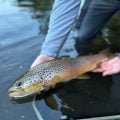Planning a Montana Fly Fishing Trip
Sponsored Content
Fly fishing in Montana is grand and planning your fly-fishing trip in our home state should be fun and exciting, not a challenge. But how do you plan the perfect trip to a state that is home to a lifetime’s worth of amazing fly fishing?
As you decide where to fish in Montana, choosing when to make a trip is equally as important. Read Yellow Dog’s When to Visit Montana Backstage Pass post to learn more about the angling calendar.
If you’re considering a trip to Montana or will be here visiting, remember that travel services like Yellow Dog’s are always free—but we’ve compiled this article to help you wade through the myriad of trip options to help you plan the perfect Montana fly fishing trip.
Montana Fly Fishing Waters
Let’s look at the state’s geography as we break down the vastness of Montana’s fly-fishing trip options. Over six hundred miles wide the Treasure State is massive in terms of waters accessible to fly fishing. Within those waters there are options to choose from as well—larger rivers best suited to fishing from a boat, smaller waters explored on foot, crystal clear spring creeks, multi-day backcountry river float trips, alpine lakes, and private access waters.
The places to fish read like a fishing Hall of Fame ballot: Madison, Missouri, Bighorn, Smith, Big Hole, Yellowstone, Bozeman, Missoula, Twin Bridges, and many other places well-known and some other places off-the-radar. We’ve got small towns near a particular river, larger towns with a variety of dining, arts, and entertainment options, secluded lodges with diverse fishing programs and professionally trained chefs, and overnight multi-day float and pack trips.
Non-Angling Activities
For non-anglers Montana has plenty to keep them engaged while others are fishing. Our two national parks, Yellowstone and Glacier, are located near some remarkable fishing. We are known for great scenery, wide-open spaces, and friendly locals. Missoula and Bozeman are vibrant towns with thriving arts and dining scenes. Helena and Great Falls, jumping off points for our Smith River trips, are steeped in Montana history and home such highlights as the Montana Historical Society Museum, the Lewis and Clark National Historic Trail Interpretive Center, and more.
Knowing the geography and the towns near our waters is important, but so is understanding the many ways to consider deciding where to make a trip.
Destination River Trips
The Missouri and Bighorn Rivers are famous tailwater rivers serviced by world-class destination lodges and local hotels and motels. Fishing trips to these rivers typically have you fishing one river and fishing it intimately, basing in or near the angling-centric crossroads of Craig or Fort Smith. These rivers have the longest angling seasons of our Montana waters and usually harbor the most consistent hatches and fish numbers and cater well to all angling abilities, yet non-angling amenities are limited.
Variety is The Name of the Game
Montana offers variety and accessibility to fish multiple waters in multiple days. The Big Hole one day, the Madison the next, a small creek on a day three, and so on. With its network of lodges and outfitters, a local travel company can arrange a trip to sample all of Montana’s great waters.
Multi-day Backcountry Float Trips
Montana’s Smith River flows for sixty miles through a spectacular backcountry canyon. The Smith River is home to limestone cliffs rising a thousand feet above the river, Native American petroglyphs, wild rainbow and brown trout, and a few native cutthroat trout. If you desire native cutthroat eating large dry flies, a multi-day wilderness style float trip on the South Fork of the Flathead is a blend of comfort and class we can book that for you as well.
Other Unique Montana Trips
From Montana’s extreme northwest corner to the Absaroka-Beartooth Wilderness and Yellowstone National Park in between, the desire to get-away-from-it-all exists in fishing less crowded waters. Book a float trip on a remote northwest Montana river or a horse-pack trip into the heart of some of the largest wilderness in the Lower 48.
What to Pack
Deciding what to pack for a Montana fly fishing trip can be an exciting, yet difficult task. Time of year, variable weather, and the waters an angler will be fishing all need to be considered when choosing the appropriate gear. Having proper gear for the time of year and waters fished will make the trip and experience much more pleasurable!
A good 9’ 5 or 6 weight rod can handle all of the favorite Montana fly fishing destinations and fishing styles. Whether an angler is fishing dry flies, streamers, or nymphs a 5 or 6 weight rod will be enjoyable on any water year round. Reels with adjustable drags and loaded with a weight forward floating fly line matched to the rod will be most versatile. A large selection of flies is also one of the more important things to pack for a trip to Montana.
Day to day changes in the fishing are very common, so being prepared to fish tricky dry fly sippers one day and cast to fish that refuse to rise the next day is important. A good selection of trout flies will get the job done throughout the year. A box full of hatch specific patterns such as mayflies, caddis and stoneflies, a box of attractor dries, along with a box of nymphs and a box of streamers are good to have at all times. Stopping into a local fly shop to get a Montana fishing license and fly details for the waters that will be fished is the best first stop. Call ahead for fly details specific waters or time of year. Note that tailwaters will fish much different than freestone streams.
Back up leaders and tippet will come in handy in the wind or when figuring out what exact size and pattern the fish are willing to eat. Additional terminal tackle such as split shot, strike indicators, floatant and maybe even a sink tip should not be left at home.
Durable and fully waterproof rain gear is a must for all seasons in Montana. Waders with wading boots and a rain jacket can transform even the coldest, wettest days to a much more pleasant experience. Puffy jackets, fleeces, sweatshirts, and some long underwear will suffice under waders for the coldest months of the year. Gloves for spring, fall, and winter can keep one’s hands warm enough to tie on flies and bear the cold. Summer storms can produce a wet and crisp chill, meaning layering to go under rain gear will be appreciated, even in August. Low temperatures on the hottest days can dip into the 40’s throughout the state. Anglers that will be out at sunrise and off the water after dark will want insulation for those cooler hours of fishing. Lightweight, quick-dry pants and a hooded shirt are the apparel of choice for hot sunny days. A buff or sun mask works well for those who do not enjoy hooded shirts.
Polarized sunglasses reduce the glare on the water, which will make seeing a strike indicator or dry fly much easier. Along with improving sight on the surface, the numerous sight fishing opportunities we have would not be possible without a pair of polarized shades. Glasses also provide great protection from the flying hooks attached to a fly fishers line. A brimmed hat will also help keep the sun out of piscator’s eyes and hooks out of their head.
Lip balm, sunscreen, and bug repellent are necessary forms of skin protection especially for summer fly fishing. Bear spray can be lumped into this section (bit of a stretch), and will make an angler feel much safer when fishing the more remote areas in the state and can save one’s life!
Carry all necessary gear, lunch, and a victory beer using a vest or fishing pack. When the fish of a lifetime is on the other end of the line, a net to land the beast will come in handy.
Fly fishing Montana is one of the most beautiful and memorable experiences. To capture the trip and hopefully get a quick shot of the massive Yellowstone cutthroat trout just landed, bring a camera!
The right gear and preparation for a Montana fly fishing trip will make that trip all that it is talked up to be!
This post was produced by MidCurrent in partnership with Yellow Dog Travel, who paid for its placement.















